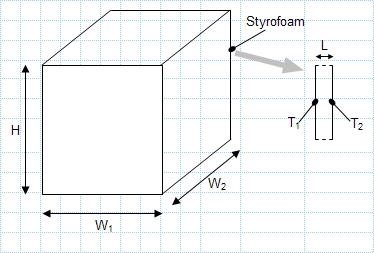Heat loss through insulated food container.xls

Description
KNOWN: Dimensions and thermal conductivity of food/beverage container. Inner and outer surface temperatures.
FIND: Heat flux through container wall and total heat load.
ASSUMPTIONS: 1) Steady State conditions.
2) Negligible heat transfer through bottom wall.
3) Uniform surface temperatures and one-dimensional conduction through remaining walls.
Calculation Reference
Fundamentals of Heat and Mass Transfer - Frank P. Incropera
To calculate the heat loss through an insulated food/beverage container, considering the dimensions, thermal conductivity of the container, and the given inner and outer surface temperatures, you can follow these steps:
-
Determine the surface area of the container: Calculate the surface area of the container, including all walls.
-
Calculate the thermal resistance of the insulation: The thermal resistance (R_insulation) of the insulation material can be calculated using the formula:
R_insulation = Thickness / (Thermal Conductivity * Area)
Where the thickness is the thickness of the insulation material and the thermal conductivity is the thermal conductivity of the insulation.
-
Calculate the thermal resistance of the remaining walls: The thermal resistance (R_walls) of the remaining walls of the container can be calculated using the formula:
R_walls = Thickness / (Thermal Conductivity * Area)
Where the thickness is the thickness of the container walls (excluding the insulation) and the thermal conductivity is the thermal conductivity of the container material.
-
Calculate the total thermal resistance: The total thermal resistance (R_total) of the container can be calculated by summing the thermal resistances of the insulation and the remaining walls:
R_total = R_insulation + R_walls
-
Calculate the heat flux: The heat flux (q) through the container wall can be calculated using Fourier's Law of heat conduction:
q = (T_inner - T_outer) / R_total
Where T_inner and T_outer are the inner and outer surface temperatures, respectively, and R_total is the total thermal resistance of the container.
-
Calculate the total heat load: The total heat load (Q) is the product of the heat flux and the surface area of the container:
Q = q * Surface Area
By following these steps, you can determine the heat flux through the container wall and calculate the total heat load for the insulated food/beverage container based on the given dimensions, thermal conductivity, inner and outer surface temperatures, and the assumptions of steady-state conditions, negligible heat transfer through the bottom wall, uniform surface temperatures, and one-dimensional conduction through the remaining walls.
Calculation Preview
Full download access to any calculation is available to users with a paid or awarded subscription (XLC Pro).
Subscriptions are free to contributors to the site, alternatively they can be purchased.
Click here for information on subscriptions.
